The Motorola Moto G4 and G4 Plus Review
by Brandon Chester on August 15, 2016 8:00 AM EST- Posted in
- Smartphones
- Lenovo
- Motorola
- Moto G
- Moto G4
Battery Life
Regardless of how good a phone's hardware is, if it can't last through the day then it's never going to provide a good user experience. We use a few different tests to analyze the battery performance of a mobile device under different workloads that put a heavy stress on a certain part of the system. In our web test, the workload is display-bound, although there is a significant amount of CPU processing done which will impact results. In GFXBench the test is GPU-bound, and in PCMark the test tries to simulate typical interactions that will make use of all the hardware. For these benchmarks I've opted to just test the Moto G4 Plus, as both the G4 and G4 Plus share the same SoC, display, and battery capacity, so there should be no difference between the two as far as battery life is concerned. As always, I'll start with our own WiFi web benchmark before moving to the battery tests that exist as part of the performance benchmarks that we use.
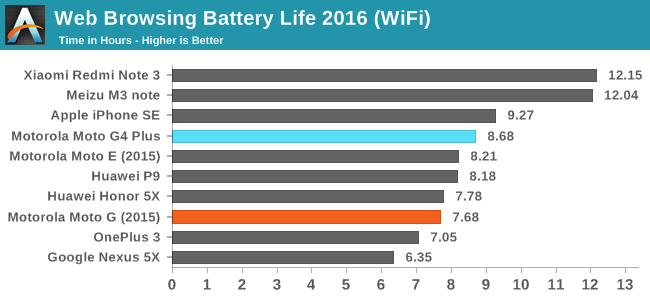
In our internal WiFi web browsing test the Moto G4 Plus lasts exactly one hour longer than the 2015 Moto G. This isn't surprising given the significant increase in the battery capacity with the move to a larger form factor, but it does put to rest any concerns about the Moto G4's higher resolution display leading to worse battery life in display-bound workloads than its predecessors.
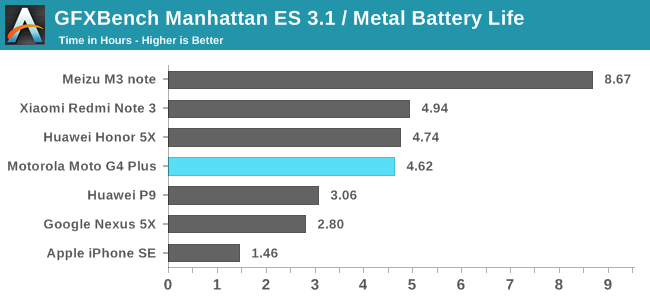
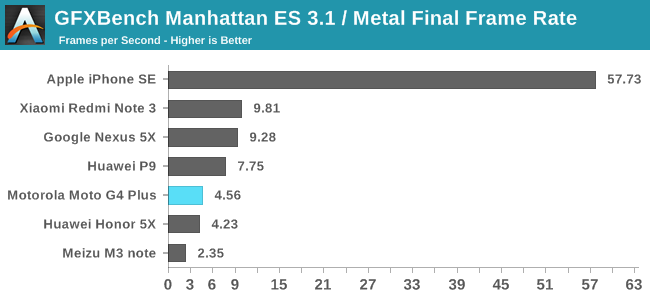
The Moto G4 performs as expected in the GFXBench Manhattan ES 3.1 battery test. Both the runtime and performance are in line with the Huawei Honor 5X, which has essentially the same specifications. Obviously a frame rate of 4.5fps isn't going to be playable, but in a graphical workload more reasonable for the Moto G4's hardware you should be able to play for a good period of time before your battery dies.
Normally I would run PCMark's battery benchmark, which is my favorite battery test because it performs tasks that users do on a daily basis. In my view it provides the best idea of whether or not a phone will last through the day. Unfortunately, I couldn't get the Moto G4 or the G4 Plus to complete the test. Early on in the benchmark it would simply freeze, and the phone would sit there in that state until it drained and died. I attempted the test three times, at which point I gave up on my attempts. The only other device this has happened to is the Google Pixel C, and we all know how that turned out. Suffice to say, this kind of issue is a hint that there are probably other software problems and stability issues in the phone's firmware, and it's not a good sign.
Charge Time
Something that I found to be quite ridiculous about previous versions of the Moto E and Moto G was the charger included in the box. This was market dependent to a degree, but in North America the first problem with the charger was that it had a low power output of roughly 2.5W. This meant that the phones charged incredibly slowly, which was a big problem when paired with the relatively large batteries in the 2015 Moto E and Moto G. On top of that, the charger was a single unit where the block and cord were connected together, rather than being a separate block and cord. This meant that by default, the Moto E and Moto G could not be connected to a computer to transfer media.
While the old charger could be somewhat excused as a cost saving measure, Motorola has clearly recognized the ridiculous nature of it. With the Moto G4 and G4 Plus they now ship a separate cord and charger. Something that confuses me is the fact that Motorola's website explicitly advertises that the G4 Plus ships with their 15W TurboPower charger. While this is the case, the normal Moto G4 unit I received also has it so it's not really a selling point for paying the extra $50 from what I can see. I'm not sure if this differs by market, so it's probably best to check the box when buying to see what charger you get inside.
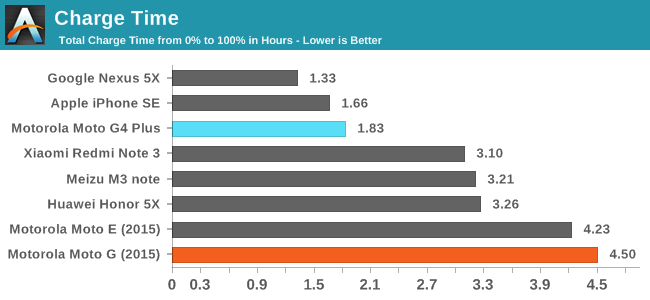
By including a reasonable charger in the box, Motorola has cut down charge time significantly. The 2015 Moto G had the longest charge time on record for a smartphone, while the Moto G4 Plus is in line with what is expected of modern smartphones. Fast charging has more than halved the time it takes to charge the battery fully, despite the fact that the battery has increased in size from 2470mAh to 3000mAh. My only complaint is that Motorola's TurboPower charger makes a whining noise when the phone reaches a full charge and is left connected. I noted this around the time of the Nexus 6 review as it uses the same charger, and I was told by many users that they don't experience this. However, I now have three of these 15W TurboPower blocks and they all do it, so I think it actually comes down to whether or not you can hear the frequency emitted. If you want to look on the bright side, it lets you know when your phone is done charging, but I think I'd rather have an LED indicator instead.


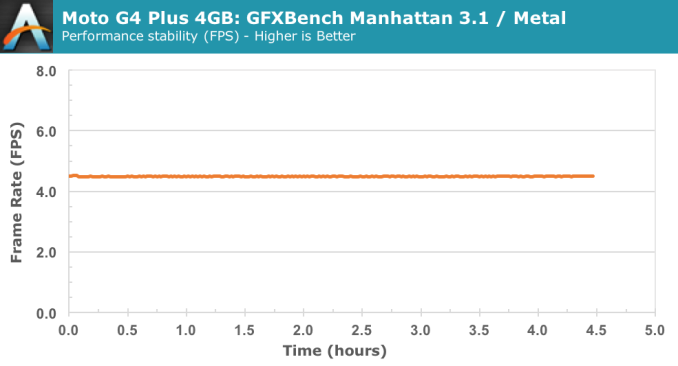
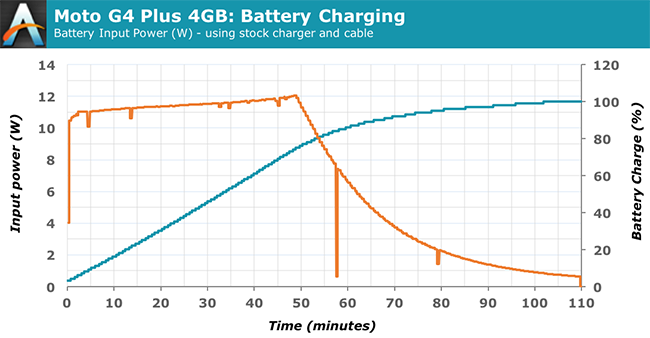








94 Comments
View All Comments
stardude82 - Tuesday, August 16, 2016 - link
Well, I picked up a Moto G4 for $125 and the Moto G4 Plus has features which the 5X doesn't have. The Nexus 5X is not that much better of a phone in my opinion and the lack of SD slot is a deal breaker for many.Cod3rror - Monday, August 15, 2016 - link
I have to say the camera on G4 Plus is very impressive in daylight pictures. I like to pixel peep and I think G4 Plus was the best out of the bunch. OP3 looks great, but if you look at the images at 100%, they look oil painted, especially the vegetation. Either the camera technology has plateau-ed or lower end devices are really upping their game in this area.Did you experience any ghost touch issues? Motorola forums are riddled with complaints about ghost touch issues with G3s and G4s.
It's disappointing to read about the jittery UI, Moto G3 is smooth (we're talking by Android standard here) and fast.
I think in general Motorola has been going downwards after Lenovo purchased them. They had issues with G3 screens with ghost touching as mentioned (build quality and design is awesome though), they clearly slacked on G4, have the same screen issues and overpriced it too (at that price, it should've been SD650).
Brandon Chester - Monday, August 15, 2016 - link
I really haven't had any issues with ghost touches or overheating or anything like that. I was playing Pokémon Go which is a relatively intensive game (partially due to terrible design) and the phone was working fine. My main issue has just been the generally poor performance.archaicertes - Tuesday, August 16, 2016 - link
I noticed ghost touch days after I bought it. Not just while charging. I returned it because they wanted us to send it in for repair and wouldn't share the solution.WPX00 - Tuesday, August 16, 2016 - link
The camera should be impressive. The OV16860 is a part meant for FLAGSHIP phones, not $250 devices. Put OIS in it and a nicer quality lens and I would be quite happy to see it on a high end LG or Nexus. OIS sometimes makes all the difference: remember the $624 Moto Z uses the same sensor as the $149 Moto G4 Amazon Edition, but with OIS and a faster lens, making it a better camera than the $249 Moto G4 Plus which in theory has a better sensor part.Sumedh - Monday, August 15, 2016 - link
I have been using g4 plus for 2 months and i would like to point out the heating problem in it ..it gets too hot while playing games and also starts lagging while charging ..and camera slows down if you use it for more than 15minssinsin - Monday, August 15, 2016 - link
One of the saddest parts is that Moto/Lenovo has put the same camera sensor (as Moto G4, Moto G 2015, Nexus 6 (2014)) on it's newest flagship Moto Z (2016).TheinsanegamerN - Monday, August 15, 2016 - link
these would be good phones if they were not made by lenovo, a company that cannot be trusted with privacy and has already confirmed they will not be providing regular updates.markiz - Monday, August 15, 2016 - link
Brandon, you mentioned a few times here that you find larger screens as having a negative impact on usability?Seeing as how I am of the opposite conviction (or have a wrong understanding of the word usability) I though it would be a good idea to explore in an article. How does smartphone screen size affect usage.
For example me, I could not care less for one handed usage, nor can i understand why would anyone care, so it would be interested to understand why.
Pissedoffyouth - Wednesday, August 17, 2016 - link
I could see on a crowded subway one handed use being popular